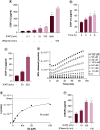Overcoming stromal barriers to immuno-oncological responses via fibroblast activation protein-targeted therapy
- PMID: 33148078
- PMCID: PMC8008208
- DOI: 10.2217/imt-2020-0066
Overcoming stromal barriers to immuno-oncological responses via fibroblast activation protein-targeted therapy
Abstract
The tumor microenvironment contributes to disease progression through multiple mechanisms, including immune suppression mediated in part by fibroblast activation protein (FAP)-expressing cells. Herein, a review of FAP biology is presented, supplemented with primary data. This includes FAP expression in prostate cancer and activation of latent reservoirs of TGF-β and VEGF to produce a positive feedback loop. This collectively suggests a normal wound repair process subverted during cancer pathophysiology. There has been immense interest in targeting FAP for diagnostic, monitoring and therapeutic purposes. Until recently, this development has outpaced an understanding of the biology; impeding optimal translation into the clinic. A summary of these applications is provided with an emphasis on eliminating tumor-infiltrating FAP-positive cells to overcome stromal barriers to immuno-oncological responses.
Keywords: FAP; TGF-β; fibroblast activation protein; immunotherapy; prostate cancer; stroma; wound healing.
Conflict of interest statement
The work was supported by Abbvie (C109738FE, [WN Brennen]), Allegheny Health Network-Johns Hopkins University Cancer Research Fund (WN Brennen, DLJ Thorek), Emerson Collective Cancer Research Fund (643396, [WN Brennen, DLJ Thorek]), the Department of Defense (W81XWH-17-1-0528, [WN Brennen]), W81XWH-16-1-0410 (JT Isaacs, SR Denmeade), and the NIH-Prostate SPORE Grant (P50 CA058236, [SR Denmeade, JT Isaacs]). The authors have no other relevant affiliations or financial involvement with any organization or entity with a financial interest in or financial conflict with the subject matter or materials discussed in the manuscript apart from those disclosed.
No writing assistance was utilized in the production of this manuscript.
Figures



Similar articles
-
Immunization of stromal cell targeting fibroblast activation protein providing immunotherapy to breast cancer mouse model.Tumour Biol. 2016 Aug;37(8):10317-27. doi: 10.1007/s13277-016-4825-4. Epub 2016 Feb 3. Tumour Biol. 2016. PMID: 26842926
-
Regulation of Fibroblast Activation Protein by Transforming Growth Factor Beta-1 in Glioblastoma Microenvironment.Int J Mol Sci. 2021 Jan 21;22(3):1046. doi: 10.3390/ijms22031046. Int J Mol Sci. 2021. PMID: 33494271 Free PMC article.
-
The application of the fibroblast activation protein α-targeted immunotherapy strategy.Oncotarget. 2016 May 31;7(22):33472-82. doi: 10.18632/oncotarget.8098. Oncotarget. 2016. PMID: 26985769 Free PMC article. Review.
-
Suppression of antitumor immunity by stromal cells expressing fibroblast activation protein-alpha.Science. 2010 Nov 5;330(6005):827-30. doi: 10.1126/science.1195300. Science. 2010. PMID: 21051638
-
What might a stromal response mean to prostate cancer progression?Cancer Metastasis Rev. 1998-1999;17(4):411-9. doi: 10.1023/a:1006129420005. Cancer Metastasis Rev. 1998. PMID: 10453285 Review.
Cited by
-
CT radiomics signature: a potential biomarker for fibroblast activation protein expression in patients with pancreatic ductal adenocarcinoma.Abdom Radiol (NY). 2022 Aug;47(8):2822-2834. doi: 10.1007/s00261-022-03512-6. Epub 2022 Apr 22. Abdom Radiol (NY). 2022. PMID: 35451626
-
Role and mechanism of fibroblast-activated protein-α expression on the surface of fibroblast-like synoviocytes in rheumatoid arthritis.Front Immunol. 2023 Mar 17;14:1135384. doi: 10.3389/fimmu.2023.1135384. eCollection 2023. Front Immunol. 2023. PMID: 37006278 Free PMC article. Review.
-
Prognostic and therapeutic potential of senescent stromal fibroblasts in prostate cancer.Nat Rev Urol. 2024 May;21(5):258-273. doi: 10.1038/s41585-023-00827-x. Epub 2023 Oct 31. Nat Rev Urol. 2024. PMID: 37907729 Free PMC article. Review.
-
Prostate fibroblasts and prostate cancer associated fibroblasts exhibit different metabolic, matrix degradation and PD-L1 expression responses to hypoxia.Front Mol Biosci. 2024 Mar 22;11:1354076. doi: 10.3389/fmolb.2024.1354076. eCollection 2024. Front Mol Biosci. 2024. PMID: 38584702 Free PMC article.
-
Fibroblast Activation Protein (FAP)-Targeted CAR-T Cells: Launching an Attack on Tumor Stroma.Immunotargets Ther. 2021 Aug 5;10:313-323. doi: 10.2147/ITT.S291767. eCollection 2021. Immunotargets Ther. 2021. PMID: 34386436 Free PMC article. Review.
References
-
- Caplan AI, Sorrell JM. The MSC curtain that stops the immune system. Immunol. Lett. 2015) (Epub ahead of print). - PubMed
-
- Costa A, Kieffer Y, Scholer-Dahirel A et al. Fibroblast heterogeneity and immunosuppressive environment in human breast cancer. Cancer Cell 33(3), 463–479 e410 (2018). - PubMed
-
- Lambrechts D, Wauters E, Boeckx B et al. Phenotype molding of stromal cells in the lung tumor microenvironment. Nat. Med. 24(8), 1277–1289 (2018). - PubMed
Publication types
MeSH terms
Substances
Grants and funding
LinkOut - more resources
Full Text Sources
Other Literature Sources
Miscellaneous
